Die Säulen der Erde
Authors: Michael Rieneck & Stefan Stadler
Publisher: Kosmos
Year: 2006
review by

| x |
|
|
|
|
|
|
|
|
|
|
|
|
|
|
|
|
|
|
|
|
|
|
|
|
|
|
|
|
|
|
|
|
|
|
|
|
|
|
|
|
|
|
|
|
|
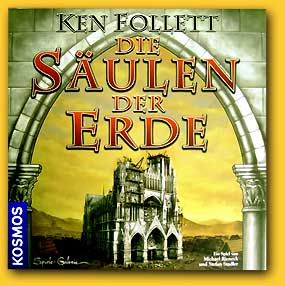 |
This game is loosely based on the bestseller with the same title by Ken Follet, that is situated in England in the twelfth century. The lives of the inhabitants of the village Kingsbridge revolve around the construction of a cathedral. And not just a cathedral, but the finest cathedral of the whole country. In the book, this automatically leads to all kinds of romantic situations, but in the game we don’t have to deal with those.
The players are responsible for the realisation of this prestigious building project. Each player has three builders in their colour that van be placed on eight different locations on the board. Three builders and eight locations: that smells like difficult choices! The builders also command twelve workers, who supply the building materials, and three to five craftsmen, who can use the building materials to build on the cathedral. Building on the cathedral brings victory points, and the player that earns the most victory points wins the game.
|
| x |
|
|
|
|
|
|
|
|
|
|
|
|
|
|
|
|
|
|
|
|
|
|
|
|
|
|
|
|
|
|
|
|
|
|
|
|
|
|
|
|
|
|
|
|
|
| The game plays in six rounds, that are each divided into three phases. At the beginning of each round, six cards with building materials (wood, stone, sand) and two cards with craftsmen are placed next to the board. In phase 1, each player chooses one of these cards, and this is repeated until there are no more cards or until all players have passed. The resource cards show how many cubes of this material can be earned in exchange for how many workers. |
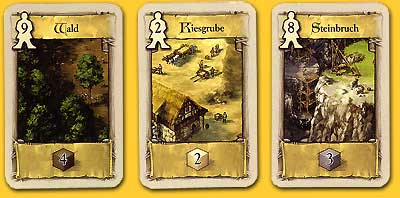 |
| x |
|
|
|
|
|
|
|
|
|
|
|
|
|
|
|
|
|
|
|
|
|
|
|
|
|
|
|
|
|
|
|
|
|
|
|
|
|
|
|
|
|
|
|
|
|
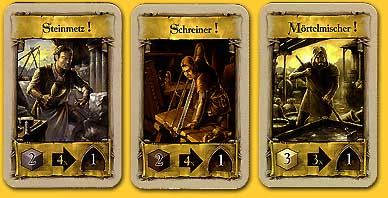 |
Each player has twelve workers in his colour. If a player selects a card that brings him 4 cubes of wood in exchange for 9 workers, he places 9 workers in the forest on the board, and places the card in front of him. The resources are distributed in a later phase in the game. The craftsmen cards can be used in a later stage in the game to convert the building materials to victory points. |
| x |
|
|
|
|
|
|
|
|
|
|
|
|
|
|
|
|
|
|
|
|
|
|
|
|
|
|
|
|
|
|
|
|
|
|
|
|
|
|
|
|
|
|
|
|
|
All players start with three craftsmen, and they are allowed to employ five. If a player selects a craftsman in phase 1, he pays the indicated amount of gold and places the card next to his other craftsmen. When he exceeds his limit of five craftsmen, he has to discard any one immediately.
In phase 2, the players place their builders on the board. The starting player draws one builder from the bag, and puts it on the cost list on the most expensive position, the 7. The owner of this builder has the choice to either pay seven gold and place his builder on the board immediately, or leave the builder on its position on the cost list. |
|
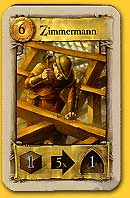 |
| x |
|
|
|
|
|
|
|
|
|
|
|
|
|
|
|
|
|
|
|
|
|
|
|
|
|
|
|
|
|
|
|
|
|
|
|
|
|
|
|
|
|
|
|
|
|
 |
|
Irrespective of his choice, the cost marker is shifted one space to the right: placing the next builder costs six gold now. This way, the cost to place a builder is reduced to zero after the seventh builder has been drawn from the bag. All the other builders that are still in the bag can be placed on the board free of charge. When the bag is empty, the builders that are still standing on the cost list because their owner refused to pay the costs can be placed on the board for free, but chances are that all attractive locations are already occupied by then! |
| x |
|
|
|
|
|
|
|
|
|
|
|
|
|
|
|
|
|
|
|
|
|
|
|
|
|
|
|
|
|
|
|
|
|
|
|
|
|
|
|
|
|
|
|
|
|
|
In phase 3, the players actions are carried out. The locations on the board are numbered 1-14, and are visited in numerical order.
1. The top event card is read out loud and the effects, that can be positive or negative, are carried out. The player that placed a builder on location 2, the Bishop’s seat, is protected from the negative outcome of the event card.
3. Each worker that has not been placed in the forest, quarry or gravel pit earns the owner 1 gold by working in the wool mill.
|
|
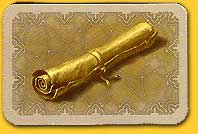 |
| x |
|
|
|
|
|
|
|
|
|
|
|
|
|
|
|
|
|
|
|
|
|
|
|
|
|
|
|
|
|
|
|
|
|
|
|
|
|
|
|
|
|
|
|
|
|
|
|
|
4. Each round two advantage cards are placed on the board. The player that placed his builder next to one of the advantage cards may now take the card and place it in front of him. Some cards can be used only once, while others can be used for the remainder of the game.
5. Players that placed their builders at the priory earn 1 or 2 victory points.
6-8. The player that placed their workers in the forest, quarry or gravel pit in phase 1 may now collect their resource cubes (wood, stone and sand).
|
| x |
|
|
|
|
|
|
|
|
|
|
|
|
|
|
|
|
|
|
|
|
|
|
|
|
|
|
|
|
|
|
|
|
|
|
|
|
|
|
|
|
|
|
|
|
|
| x |
|
|
|
|
|
|
|
|
|
|
|
|
|
|
|
|
|
|
|
|
|
|
|
|
|
|
|
|
|
|
|
|
|
|
|
|
|
|
|
|
|
|
|
|
|
 |
|
|
|
|
|
|
|
|
|
|
|
|
|
|
|
|
|
|
|
|
|
|
|
|
|
|
|
|
|
|
|
|
|
|
|
|
|
|
|
|
|
 |
|
|
|
|
|
|
|
|
|
|
|
|
|
|
|
|
|
|
|
|
|
|
|
|
|
|
|
|
|
|
|
|
|
|
|
|
|
|
|
|
|
 |
|
|
|
|
|
|
|
|
|
|
|
|
|
|
|
|
|
|
|
|
|
|
|
|
|
|
|
|
|
|
|
|
|
|
|
|
|
|
|
|
|
| x |
|
|
|
|
|
|
|
|
|
|
|
|
|
|
|
|
|
|
|
|
|
|
|
|
|
|
|
|
|
|
|
|
|
|
|
|
|
|
|
|
|
|
|
|
|
 |
|
|
|
|
|
|
|
|
|
|
|
|
|
|
|
|
|
|
|
|
|
|
|
|
|
|
|
|
|
|
|
|
|
 |
|
|
|
|
|
|
|
|
|
|
|
|
|
|
|
|
|
|
|
|
|
|
|
|
|
|
|
|
|
|
|
|
|
|
|